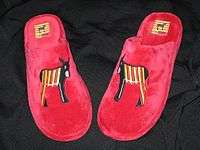Catalan donkey
The Catalan donkey (Catalan: 'Ase Català' or Ruc Català; Eastern Catalan: [ˈruk kətəˈla]; Spanish: 'Asno Catalán') is a breed of large domestic donkey from Catalonia, in north-eastern Spain and south-western France. Approximately 80% of the population is in Catalonia, and approximately 20% is in Northern Catalonia.[1]
 Catalan donkey | |
| Other names |
|
|---|---|
| Country of origin | Spain, France |
| Distribution |
|
| Traits | |
| Height |
|
| Classification | |
| MAPA (Spain) | Breed standard |
| |
History
Some authors believe the Catalan donkey to be related to the donkey of Mallorca and the Zamorano-Leonés donkey.[2] The breed is considered to be very old;[3] Pliny the Elder mentioned that there were donkeys on the plain of Vic (Osona).[1][3]
The Catalan donkey originates in the basins of the Cardener, Segre and Ter rivers.[1] In the past it was very important on farms but due to declining use and numbers the Catalan donkey was in danger of extinction. There were once as many as 50,000.
A herd-book was established in 1929. Numbers fell during the Spanish Civil War, but recovered in the next decade. In the 1960s and 1970s rural depopulation and the mechanisation of agriculture led to a new decline in numbers. A breeders' association, the Associació pel Foment de la Raça Asinina Catalana, was formed in 1978 and the herd-book re-opened.[3] Much of the credit for the recovery of the breed is given to one person, Joan Gassó i Salvans from the comarca of Berguedà.[4] In 2004, 32% of the registered population of 336 were on his finca in Olvan.[3] An official national genealogical herd-book was opened in 2002. At the end of 2013 the total population in Spain was recorded as 851.[5] The Ministerio de Agricultura, Alimentación y Medio Ambiente, the Spanish ministry of agriculture, lists the breed as "in danger of extinction".[1]
The Catalan donkey has been used to improve donkey breeds elsewhere in the world, including France and North America.[6][2]
Characteristics
The Catalan donkey is a large breed, and generally weighs between 350–450 kilograms (770–990 lb).[7] Jacks average 142 centimetres (56 in) in height, and jennies 136 centimetres (54 in).
Symbolism

Recently, advocates of Catalan nationalism have adopted the Catalan donkey as a symbol opposite the Toro de Osborne, typical for Andalusia.
There are also stickers for cars and scooters. A few people also do not regard the Catalan donkey as a symbol of Catalonia, but only as a way to try ridicule the Andalusian bull.
References
- Raza equino asnal CATALANA Archived 5 March 2016 at the Wayback Machine (in Spanish). Ministerio de Agricultura, Alimentación y Medio Ambiente. Accessed May 2014.
- Ase català (in Catalan). Generalitat de Catalunya: Departament d'Agricultura, Ramaderia, Pesca, Alimentació i Medi Natural. Accessed July 2014.
- Jordi Jordana Vidal (2004). Catalan donkey breed: Origins and history. Universitat Autònoma de Barcelona: Facultat de Veterinària, Departament de Ciència Animal i dels Aliments. Accessed July 2014.
- [s.n.] (7 March 2012). Mor el 'pare' del ruc català (in Catalan) El Punt Avui. p. 28. Accessed July 2014.
- Raza equino asnal CATALANA: Datos censales (in Spanish). Ministerio de Agricultura, Alimentación y Medio Ambiente. Accessed May 2014.
- Diane Jones. The Mammoth Jack Windt im Wald Farm. Accessed March 2012
- Resolución ARP/680/2002, de 26 de marzo, por la que se reglamenta el Libro Genealógico de la raza asnal catalana Archived 4 March 2016 at the Wayback Machine (in Spanish). Ministerio de Agricultura, Alimentación y Medio Ambiente. Accessed May 2014.
External links
- The Catalan donkey breed
- Fuives - world centre of the Catalan donkey
| Wikimedia Commons has media related to Burro Català. |